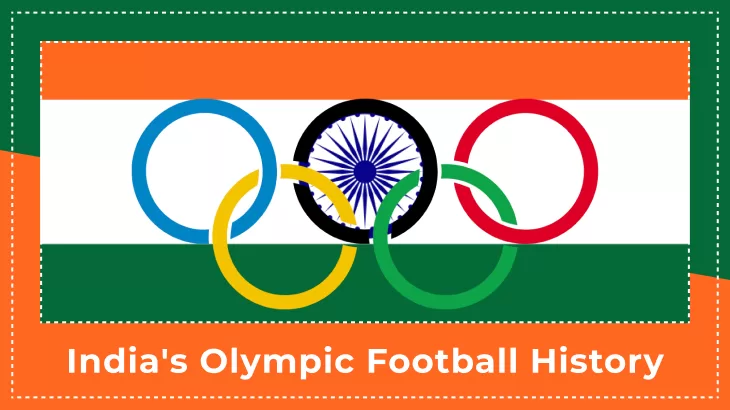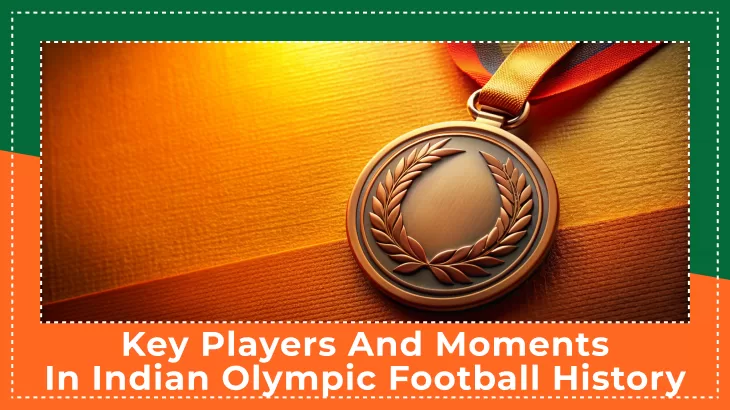Historic Feat: Indian Football’s Quest for an Olympic Medal
India’s connection to football runs deep, and dates back to the early 20th century. Despite numerous highs and lows throughout the history of Indian football, no story can be more compelling than that regarding an Olympic medal. The Olympics is the biggest stage they can ever reach and that has always been an aspiration for any Indian football team.
The Game: Olympic Games are a prestigious event for athletes across the globe and Indian footballers (not an exception) have always dreamt to participa… The Olympics is a proud event and an opportunity to perform against top international talent. The history of Indian football in the Olympics has episodes worth cherishing: 1956 Melbourne Olympics. It was then that the Indian side qualified for the semi-finals in games which are indelibly etched in memory of football lovers. In the end, India lost out on a bronze medal as they went down in an intensely fought 4th and final quarter to narrowly miss a place among the podium.
The FIFA World Cup is a distant glimmer as far as Indian football is concerned, so the Olympics poses itself closer. They have shown the kind of promise at international matches and tournaments that, with proper support and infrastructure in place, should enable them to make an impact on the Olympic stage.
Recent years have seen initiatives like the Indian Super League trying to take football in India a step forward and promoting young talent that has come out of academy systems such as AIFF’s. Football academies are on the rise and involvement of experienced coaches like Syed Abdul Rahim is aiding in nurturing future generation footballers as well. The exercise, as per SAI chief Neelam Kapur is part of the preparations going on in top training centers across the country for India to be at its best shape and form ever when it sets out to compete at various global events such as Olympics with an ultimate aim of changing color of Olympic medal garnered by shooting.
India’s Olympic Football History

As you will no doubt know, the history of football in India is long and high-spirited; contributing to some roots that are inherent with cultural heritage surrounding sport within the country. Even though cricket overshadows it all, football has been very much dear to many Indians. Everything, however, pales before the quest for an Olympic medal in football. In this edition we take a look at the Olympian struggle of Indian football, its foot soldiers and some moments etched in collective memory.
The formative years and the first foray into this world
The long journey of the Indian Football team in the Olympics began in the early twentieth century. Football was not as structured and well-endowed like it is today at that time. However, the spirit and passion of Indian players was unmistakable. 1948 – The national football team made its Olympic debut in 1948, an important year because it was the first event held after India’s independence. This was debut at an international level and a new era started in Indian sports. The legendary Sailen Manna and a few hall-of-fame footballers led the team which went onto be one of the most respected clubs in Indian Footballing history.
Golden Era: India Emergence
The post-independence period saw the Indian national football team’s tournament stature grow for coming just short of being a part of World Cups. That 1948 London Olympics shaped. We had Indians playing barefooted and it was an amazing sight yet they were so skillful, disciplined. India went down fighting to France 2-1, but they won plaudits for an impressive display. This game opened the doors for India to play international football in the years that followed.
Barefoot Wonders of 1948 London Olympics
These barefoot wonders played their first Olympics in 1928, but they became truly admired after the 1948 London Olympics. It not only made a cultural statement but was proof of the grit and flexibility these individuals have. Though India lost to France, the Indian players did make a mark on international football as everyone in attendance must have taken back something alongside their thoughts of Italy. It was a landmark match in Indian cricket, showcasing the country’s huge talent pool and love for a sport that is best played against tough opponents.
A Fourth-Place Finish That Made History at the 1952 Helsinki Olympics
After the historic summit, Indian football reached another milestone in the 1952 Helsinki Olympics. Under the captaincy of Sailen Manna, the team delivered a good play. The competition was tough but the Indian team did get a solid fourth place. The achievement was lauded back home and is still considered one of the high points in Indian football to this day.
Melbourne 1956 Olympics: Did Not Enter Last Four
Melbourne Olympic 1956 is a monumental event in the history of Indian football. It was also the first time an Asian nation had made it to their way that far as a team in the semi-finals. It was an indication of their growing capability and culmination. It was Neville D’Souza who turned out to be the star performer of this event, converting a hat-trick against Australia which paved the way for India into the semis. They finished last after losing the bronze medal match but this achievement is a significant milestone for India.
Decline and Lost Opportunities
However, Indian football began to decline in the following decades. The national team failed to match their previous success and repeatedly fell short of qualifying for the Olympics. The lack of infrastructure, funding, administrative factors etc., are some reasons that led to this downtrend. The Indian Olympic team which dreams of success in football today is faced with plenty of problems, and this brings home the issue regarding sustaining winning on an international stage.
Attempts in The Past And Struggle To Qualify
In the last decade or so, there have been collective efforts from all parties concerned to revive Indian football and ultimately realize that Olympic medal dream. This has given an opportunity for young talent to display their skills on the bigger stageBig stages like Indian Super League (ISL) have played a very important role. However, the trip is hard. The Indian national football team has been historically poor; it has never qualified for the FIFA World Cup and only played in a few Olympic games on account of being hosts. This all aside, the fighting spirit and determination of Indian players seem to keep account for something.
Key Players and Moments in Indian Olympic Football History

Legend: Sailen Manna, Neville D’Souza, P.K. Banerjee
Over the years, several iconic figures have represented Indian football and their contributions to the sport has been invaluable. Sailen Manna, who is usually considered the best ever defender and took the lead during India’s early Olympic campaigns. The hat-trick scored by Neville D’Souza, which still adorns the history of 1956 Melbourne Olympics as one of Indian football’s finest hours. P.K Banerjee, a legend, ensured India maintained presence at the world stage in football by creating another historic win against mighty South Korea during the 1960s.
Unforgettable Matches and Performances
The India national football team has given many incredible performances over the years which to this date inspire generations. The 3rd place play-off in the Melbourne Olympics of 1956 was an example: a defeat, but displaying enough resources and talent. The exposure of playing against international giants like South Korea as well European teams have been significant, proving that India can fight with the best of them. When you set the football field alight for other nations… no prizes!!…. but priceless, indomitable kicks of proud we!!!
A Window into the World of Indian Football
The global arena has seen some significant consequences of the journey taken by Indian football. India’s performance in international tournaments and the hardships the players have to go through, but they tell you a story about how good an Indian player can be or want to play for his nation. Indian and British players played a major role in the early years that helped define the sport. The India football federation has been doing its bit to promote and develop the sport of late, especially with a couple of grassroots development programs as well providing international exposure.
Road Ahead
In recent years, Indian football has seen some positive signs such as better investment in infrastructure, coaching and player development. The ISL has had a significant effect in raising the standard of domestic football, and enticing some high quality international players & coaches. The hope is that these initiatives will lead to a deeper pool of talent which can compete on the world stage – and yes, possibly even at an Olympics.
The allure of giving India a badge at football’s Olympic party still has some magical charm. With the performances of past legends to inspire them and loyal fans raining in adulation, the national team endures. Building more towards the future, a big leap for football in India is not far-fetched given time and investment-node-interest entails.
Challenges and Setbacks in Indian Football

No Infrastructure and Investment
The history of Indian football has seen its glorious moments and played witness to dark chapters. India took its first steps in the direction when it made its debut at the 1948 London Olympic Games. This marked the Indian national football team’s first-ever appearance on the world map, and it was the dawn of a new era. Despite this boost in interest, the sport has also seen its fair share of struggles over the years; without many areas to develop around and not enough investment.
Facilities were poor and training grounds even worse in the formative years of Indian football. While cricket was endowed with generous support, football could not find backers who were prepared to invest in constructing stadiums or academies for developing young talent and professional teams. This lack of investment then stunted the growth, leaving many players who could have made it to international standards without a means of doing so.
Challenges in the Administration And Governance
India has seen a number of administrative problems as well in football. This has criticized the managing body of Indian football, AIFF for their inept and visionless project management. There has been negligence and poor governance, amid infighting within the federation that manifests in amateurish unfolding of affairs. These are the issues that have stood in the way of Indian football and denied its growth at grassroots level.
The Indian football federation has come under heavy fire for a lack of effective talent development or league competition. The administrative failures manifests itself on the pitch as India is unable to produce consistent performances at national level and has failed to turn into a force in Asian football.
Low standard of cricket & competition from other sports
Cricket is also a big challenge in Indian football. Cricket is not a game in India, its religion Cricket, with all its glamor and financial benefits on one side and success of the Indian cricket team on the other has doused football to an extent. That’s why young athletes are eventually swayed by cricket where there is a perceived larger prospect of fame and fortune.
Further pushing football into the margins are other sports that have considerable support and success, such as badminton or field hockey. This competition for eyeballs and dollars has made it an uphill task to capture the sporting imagination of the Indian public, which ultimately translates into investments that team sports like football need.
No opportunity for international tournaments
Without doubt, exposure to international competition is one of the cornerstones for the development of a sport. Unfortunately, the Indian national football team has not been able to play the top teams around the world for a long time. The lack of exposure has prevented the team from growing and kept top-tier talent players at bay because they lack competitive experience.
For several years, India were restricted to playing relatively few friendlies and had little involvement in major tournaments apart. So as a result, the players in the Indian football team had less match practice which could have honed their skills and given them an exposure to play various styles. It did the team no favors that they were cut off from most of the global footballing community.
The Current State of Indian Football

Recent Developments & Initiatives
However, there have been many positives in recent years which suggest that Indian football may just be primed for a resurgence. Realizing that changes were necessary, different actors in the game have brought about ideas meant to revamp the sport and its infrastructure.
That has been started with the Indian Super League launched in 2014 one of the biggest steps. The ISL professionalize) the level of Indian football, attracted several foreign players and coaches as well a decent television coverage. Simultaneously, the league has offered a venue for young Indian players to show off their skills and further develop.
And then Came the Indian Super League (ISL)
The Indian Super League has revolutionized football in India. Drawing its inspiration from world-renowned leagues such as the English Premier League and Major League Soccer, ISL has taken Indian football to a whole new level of excitement and challenge. With direct corporate and celebrity backing of teams in major Indian cities, the league has also been able to push up profile points for franchises.
Not that the quality of football has not improved in India, but it is only after several foreign players and coaches came here did Indian footballers realize how much they need to learn. The ISL has also been instrumental in upgradation of infrastructure as several clubs have put money into setting up world class training facilities besides successfully coming out with stadiums.
Youth Development and Grassroots Programs
Youth developmentIn his efforts to ensure the long term success of Indian football, one area that Patel has concentrated on is with youth development and grassroots programs. Women’s Intercontinental CupAnalysis: High time we took Female Grassroots Football seriously in IndiaAn AIFF partnered organization has been starting & implementing many projects to spot, develop and mold young talents. The scan will be launched with various programs such as the development of football academy, scouting camps for talents and youth leagues.
Grassroots- The Crux of Development Of A Sport If India is introduced to football at an early age along with quality coaching and training facilities available, the nation can eventually have a pool of talented children who could represent their respective country in football. These initiatives are beginning to pay off with an increasing number of young footballers emerging from the professional set up and shining in ISL.
History of the National Team that Proved a Focal Point in India The Higher Edge
The performance of the Indian national football team is a significant contributing factor to wider interest in and appeal for the sport across India. A strong national team creates buzz and intrigue with the fans which in turn increases television ratings, publicity, fan interest for football. This incentivizes sponsors and investors who in turn stimulates progress – a virtuous growth-producing cycle
The Blue Tigers, which is the name of the Indian national team, have showcased… Coached at local level by experienced coaches and with a stronger development pathway via the domestic league, they have now produced some impressive performances on recent outings. For example, India fare well in the AFC Asian Cup while also enjoying a good run during SAFF Championship which is a tournament conducted by South-Asian nations.
Future Prospects for Indian Football at the Olympics

That is pretty much where Indian football has come from in its nascent years. There is the opportunity of qualification and success at future Olympic Games but it needs work in various places.
It Can Qualify And Pass.
India’s National Football Team (also known as the Blue Tigers) has seen various highs and lows throughout their history. Challenges have occurred, yet the team has remained resilient and determined. And the future for success lay in developing a strong talent pipeline from bottom to top. This is why investments into youth travel programs, better infrastructure and exposure to international competitions are part of the solution towards this end.
In this aspect, the importance of the Indian Super League (ISL) cannot be understated. The ISL has not just made football in our country more popular, but it gave young talents somewhere to show what they can offer. This measure should help in seamlessly integrating the objectives of ISL into those defined by the Indian football federation, which would reflect positively on tackling this pressing issue and make sure that the national team has a consistent pool top draw from.
Besides, valuable lessons will also be taken from the success of some Asian teams like South Korea and Japan. These nations have actually long executed well at large competitions the similarity of the Olympics as well as FIFA World Cup. Implementing the best coaching, training and sports science practices for the Indian team can improve their presence at the world stage.
The Significance of Long Term Planning and Investment
Long term vision and continued investment is required to achieve success in international football, especially at the Olympics. It’s a lesson learned from the history of Indian football – that short-term fixes will never be enough to match up against the best sides in the world. Consequently, there needs to be a holistic plan targeting long term goals by the Indian football federation.
Infrastructure investment is key. Elite athletes require modern training facilities, state-of-the-art stadiums and access to high quality sports medicine. Also, tie-ups with reputed football clubs and academies in Europe and South America can give Indian players playing time across high level competition as well as training methodologies.
Secondly, creating a culture of professionalism in Indian football is the need of the hour. They did so by focusing on enhancing the coaching level, setting up fitness and nutrition standards at even lower levels of play and attending to players’ mental health. Once that is addressed, the Indian national team will be in a prime position to grow further with an exciting pool of talent and achieve more success on Olympic level.
The Fans and Supporters Pushing the Sport at Large
No one is crazier about football than Indian fan. The streets are buzzing with activity in Kolkata, the stadiums thrumming at Kerala; India breathes football. In fact they are instrumental in pushing the sport further and can lead to inspire thousands of young players.
Fan interaction on multiple platforms like social media, fan clubs and community events can play a huge part in invoking an even stronger bond between the team from their supporters. Apart from keeping the players spirits high, a dedicated fan base also lures sponsors and investors which in turn contribute to football growing by leaps and bounds around India.
In addition, the media must also play their role to promote the sport. Meanwhile can dig up coverage of domestic leagues, international matches and player profiles generating a buzz around football airing it all out for their visibility. By celebrating the feats and journeys of Indian footballers, it will only make young kids interested to opt for ball sports instead of returning home post school.
Conclusion
If evidence is needed of what could be achieved through Indianization and injection of emotion in the sport, we need to look no further than India’s football history at the Olympics. From the days of playing barefoot to facing European teams, what a ride it has been! Nonetheless, it leaves her still desperate for that Olympic medal.
New Oly Dream Needs Multi-Faceted Approach It means investing in youth development, building infrastructure, learning from the best (from successful footballing nations), and culture of professionalism. Also, the fans and media have to play an important role together in shaping Indian football at large.
The ambition to win a Olympic medal lives on as Indian football team eyes prideful pursuit If proper planning and subsequent sustaining can be maintained than the Blue Tigers will Bello from global standards, thus making India proud. Yes, the path remains fraught with difficulties but it’s a fight Indian football has and will continue to endure. A shot at Olympic glory is not too far-fetched either.


